When it comes to vehicle maintenance and performance, one of the most severe issues a driver can face is a seized engine. This catastrophic failure can leave you stranded and potentially lead to costly repairs or even the need for a complete engine replacement. In this article, we’ll dive deep into what a seized engine is, its causes, symptoms, and what you can do if you encounter this issue.
What is a Seized Engine?
A seized engine, often referred to as a “locked” engine, is a condition in which the engine’s components can no longer move freely. This means that the crankshaft, pistons, and other internal parts are unable to rotate, effectively rendering the engine inoperable. A seized engine typically results from severe internal damage or a lack of lubrication.
Causes of Engine Seizure
Understanding the causes of engine seizure is crucial for prevention and early detection. Here are some of the most common reasons:
- Lack of Lubrication: Oil is vital for lubricating the moving parts of the engine. Insufficient oil levels or dirty oil can lead to excessive friction, overheating, and ultimately seizing.
- Overheating: Engines generate a lot of heat. If the cooling system fails, the engine can overheat, warping components and causing them to seize.
- Corrosion: Moisture can lead to rust and corrosion inside the engine, which can cause parts to stick together.
- Engine Wear: Over time, the components within an engine wear down. If this wear is not addressed, it can lead to a seized engine.
- Foreign Objects: Sometimes, debris can enter the engine and cause blockages or damage that can lead to seizing.
- Improper Assembly: For rebuilt engines, improper assembly can result in parts misalignment, leading to seizure.
Symptoms of a Seized Engine
Recognizing the symptoms of a seized engine early can help prevent further damage. Here are some signs to watch for:
- Strange Noises: Knocking, grinding, or rattling noises before the seizure can indicate serious problems.
- Loss of Power: A sudden decrease in power, especially when accelerating, can be a warning sign.
- Smoke or Steam: If smoke or steam is coming from the engine, it’s a clear sign of overheating.
- Warning Lights: Dashboard warning lights, particularly oil pressure or check engine lights, should not be ignored.
- Difficulty Starting: If the engine struggles to start or makes a clicking sound, it may be seizing.
Diagnosing a Seized Engine
If you suspect that your engine has seized, it’s essential to diagnose the problem accurately. Here’s how you can do it:
- Check the Oil Level: Look at the dipstick to see if the oil level is low or if the oil appears dirty;
- Listen for Noises: Pay attention to any unusual sounds when attempting to start the engine.
- Inspect for Leaks: Look underneath the vehicle for any signs of oil or coolant leaks.
- Attempt to Turn the Crankshaft: Using a wrench, try to turn the crankshaft manually. If it doesn’t budge, the engine may be seized.
- Consult a Mechanic: If you’re not able to diagnose the issue, consult a professional mechanic for a thorough inspection.
What to Do If Your Engine is Seized
If you confirm that your engine has seized, here are the steps you should take:
- Do Not Attempt to Start the Engine: Trying to start a seized engine can cause more damage.
- Get a Professional Diagnosis: Take your vehicle to a mechanic for a complete assessment.
- Consider Repairs or Replacement: Depending on the extent of the damage, you may need to repair or replace the engine.
- Discuss Options: Talk with your mechanic about the best course of action and potential costs involved.
Preventing Engine Seizure
Prevention is always better than cure; Here are some ways to prevent your engine from seizing:
- Regular Oil Changes: Keep your engine oil clean and at the proper level by changing it regularly.
- Monitor Engine Temperature: Make sure your cooling system is functioning correctly to avoid overheating.
- Check for Leaks: Regularly inspect for any oil or coolant leaks that could lead to engine damage.
- Listen for Unusual Noises: Pay attention to your engine’s sounds and address any concerns promptly.
- Follow Maintenance Schedule: Adhere to the manufacturer’s recommended maintenance schedule for your vehicle.
A seized engine can be a daunting issue for any vehicle owner. Understanding the causes, symptoms, and preventative measures can save you time, money, and stress. Regular maintenance and prompt attention to warning signs are key to keeping your engine running smoothly. If you suspect your engine may be seized, don’t hesitate to seek professional help to diagnose and resolve the issue before it leads to more extensive damage.

